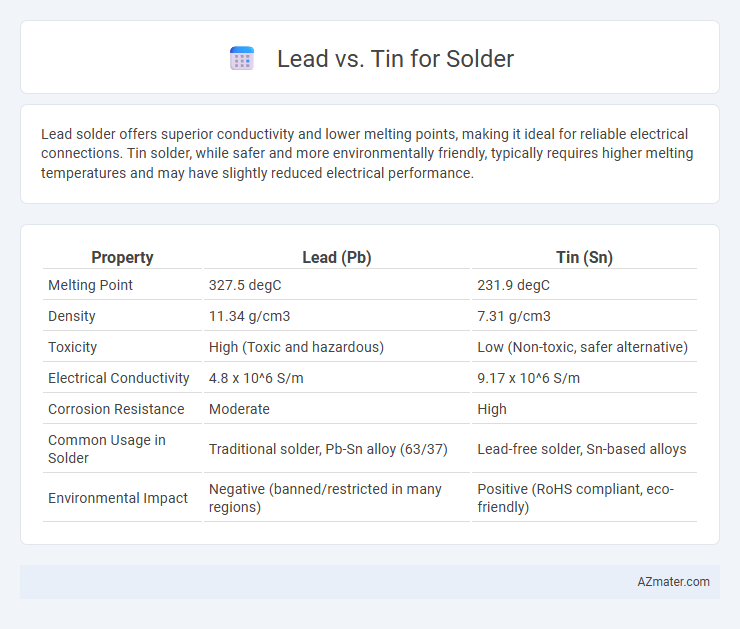Lead solder offers superior conductivity and lower melting points, making it ideal for reliable electrical connections. Tin solder, while safer and more environmentally friendly, typically requires higher melting temperatures and may have slightly reduced electrical performance.
Table of Comparison
| Property | Lead (Pb) | Tin (Sn) |
|---|---|---|
| Melting Point | 327.5 degC | 231.9 degC |
| Density | 11.34 g/cm3 | 7.31 g/cm3 |
| Toxicity | High (Toxic and hazardous) | Low (Non-toxic, safer alternative) |
| Electrical Conductivity | 4.8 x 10^6 S/m | 9.17 x 10^6 S/m |
| Corrosion Resistance | Moderate | High |
| Common Usage in Solder | Traditional solder, Pb-Sn alloy (63/37) | Lead-free solder, Sn-based alloys |
| Environmental Impact | Negative (banned/restricted in many regions) | Positive (RoHS compliant, eco-friendly) |
Understanding Soldering: The Role of Lead and Tin
Lead and tin are the primary metals used in solder due to their complementary melting points and mechanical properties, with lead providing low melting temperature and ductility, while tin offers strength and oxidation resistance. The traditional lead-tin solder alloy, typically in a 60/40 ratio, ensures reliable electrical connections and thermal conductivity essential for electronic component durability. Understanding the balance between lead's softness and tin's hardness is crucial for optimized solder joint performance, especially in electronics manufacturing and repair.
Historical Overview of Lead and Tin in Solder
Lead and tin have been the primary metals used in solder since the early 20th century, with the traditional 60/40 lead-tin alloy dominating electronics assembly due to its low melting point and excellent mechanical properties. During the late 20th century, increasing health and environmental concerns about lead toxicity prompted a global shift toward lead-free solders, which often rely on higher percentages of tin combined with metals like silver and copper. Despite this transition, lead-tin solder remains valued in specific industrial applications for its reliability and ease of use, preserving its historical significance in electrical and plumbing soldering practices.
Chemical and Physical Properties: Lead vs Tin
Lead (Pb) and tin (Sn) differ significantly in their chemical and physical properties relevant to soldering; lead has a melting point of 327.5degC, while tin melts at 231.9degC, making tin-based solders melt at lower temperatures. Chemically, lead is denser (11.34 g/cm3) compared to tin (7.31 g/cm3), and tin exhibits better corrosion resistance and forms more stable intermetallic compounds with copper, enhancing joint durability. The toxicity of lead contrasts with tin's relatively low toxicity, influencing the choice of solder materials in environmental and health-conscious applications.
Electrical Conductivity Comparison
Lead solder typically exhibits an electrical conductivity of approximately 4.8 million siemens per meter (S/m), while tin solder demonstrates a slightly lower conductivity around 9.1 million S/m, making tin more conductive in pure form. However, common lead-tin solder alloys, such as the 60/40 mix, balance mechanical strength and acceptable electrical performance with conductivity values near 6-7 million S/m. Choosing between lead and tin solder influences circuit efficiency, signal integrity, and thermal management based on their distinct conductive properties.
Melting Point Differences and Their Impact
Lead solder typically melts at around 183degC (361degF), while tin-based solders vary but often melt higher, around 217-221degC (423-430degF) for common Sn-Ag-Cu alloys. The lower melting point of lead solder allows for quicker, energy-efficient soldering with less thermal stress on components. Conversely, higher melting points in tin solder enhance joint strength and thermal reliability but require longer heating times, impacting delicate electronic assemblies.
Health and Environmental Concerns
Lead solder poses significant health risks due to its toxic properties, causing neurological damage and developmental issues upon exposure. Tin solder, especially lead-free varieties, offers a safer alternative with lower toxicity and reduced environmental impact during manufacturing and disposal. Regulatory bodies worldwide have increasingly restricted lead solder usage to minimize lead contamination in ecosystems and human populations.
Durability and Reliability of Lead vs Tin Solder
Lead solder offers superior durability due to its lower melting point and better mechanical strength, providing reliable joints that resist fatigue and thermal cycling. Tin solder, especially lead-free alloys, exhibits improved environmental safety but can be more brittle, potentially compromising long-term reliability in high-stress or high-temperature applications. Choosing between lead and tin solder depends on balancing durability demands with regulatory compliance and environmental considerations.
Applications and Industry Preferences
Lead-based solder remains preferred in electronics manufacturing for its superior mechanical strength and reliable electrical conductivity, especially in high-performance and industrial applications such as aerospace and automotive electronics. Tin-based solder, favored in consumer electronics and environmentally sensitive industries, complies with RoHS regulations due to its non-toxic composition and offers excellent corrosion resistance. The shift towards tin solder corresponds with growing regulatory pressures and industry trends emphasizing sustainability and health safety in mass-produced electronic devices.
Regulatory Standards and Restrictions
Lead-based solder historically dominated electronics due to its low melting point and reliable performance but faces stringent regulations such as the EU's RoHS directive, which restricts lead content to minimize health and environmental risks. Tin-based solder, often combined with silver and copper (SAC alloys), serves as a compliant alternative in lead-free soldering processes, meeting global standards including RoHS and WEEE for hazardous substance reduction. Compliance with these regulations is critical for electronics manufacturers to ensure product safety, environmental sustainability, and market access across regulated regions.
Choosing the Right Solder: Key Factors to Consider
Choosing the right solder involves evaluating factors such as melting point, electrical conductivity, and toxicity. Lead solder offers lower melting temperatures and excellent joint reliability but poses health and environmental risks due to lead content. Tin-based solders, especially lead-free alloys like tin-silver-copper, provide safer alternatives with good mechanical strength and compliance with RoHS regulations, making them ideal for electronics requiring environmental safety standards.

Infographic: Lead vs Tin for Solder
 azmater.com
azmater.com